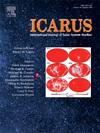Physical properties of subsurface water ice deposits in Mars’s Mid-Latitudes from the shallow radar
IF 3
2区 物理与天体物理
Q2 ASTRONOMY & ASTROPHYSICS
引用次数: 0
Abstract
Understanding Mars’s water budget and distribution is crucial for evaluating its habitability and studying its evolution and past climate. Evidence for past and present glaciation includes geomorphological features: polar ice caps and subsurface ice. Among the most compelling evidence are Viscous Flow Features (VFFs), which suggest the presence of water ice due to surface patterns similar to Earth’s rock glaciers and debris-covered glaciers. These features, including Lobate Debris Aprons (LDAs), are found in the mid-latitudes (30° and 50°) of both hemispheres.
This study focuses on the composition of LDAs, which are large, ice-rich deposits found on slopes of massifs. Two hypotheses for their formation propose either low water ice content (30%) (“rock glaciers”) or near-pure water ice under a debris layer (“debris-covered glaciers”). Using SHARAD (SHAllow RADar) data, we calculate two key parameters – dielectric constant () and loss tangent () – to better understand the purity and composition of these deposits. Previous studies suggest LDAs consist of nearly pure water ice. Our work increases global coverage across the northern and southern hemispheres, examining five sites with enhanced data coverage and incorporating both and to improve the analysis.
Our results indicate that LDAs are most likely part of a global population of features composed of 80% water ice, supporting the debris-covered glacier hypothesis. The results also point to the consistency of the debris cover across the globally distributed sites. This finding suggests that these features formed under similar climatic conditions, such as might occur under a specific orbital configuration. The high purity of the ice in LDAs has significant implications for understanding Mars’s past climate and for future exploration, as LDAs represent accessible reservoirs of water ice at mid-latitudes. Additionally, our findings highlight the need for future radar-based studies to incorporate the calculation of the loss tangent, as this can alleviate the sensitivity to the topography of the LDA base inherent in .
浅层雷达探测火星中纬度地区地下水冰沉积物的物理特性
了解火星的水预算和分布对于评估其可居住性和研究其演变和过去的气候至关重要。过去和现在冰川作用的证据包括地貌特征:极地冰帽和地下冰。其中最令人信服的证据是粘性流动特征(vff),这表明由于表面模式类似于地球上的岩石冰川和碎片覆盖的冰川,水冰的存在。这些特征,包括叶状碎片围裙(lda),在两个半球的中纬度(30°和50°)被发现。这项研究的重点是lda的组成,lda是在地块斜坡上发现的大型富冰矿床。关于冰川的形成,有两种假设:一种是低水冰含量(30%)(“岩石冰川”),另一种是在碎片层下的接近纯净的水冰(“碎片覆盖的冰川”)。利用SHARAD (SHAllow RADar)数据,我们计算了两个关键参数——介电常数(λ)和损耗正切(tanδ),以更好地了解这些沉积物的纯度和成分。先前的研究表明,lda由几乎纯净的水冰组成。我们的工作增加了北半球和南半球的全球覆盖范围,检查了五个数据覆盖范围扩大的地点,并结合了柱′和tanδ来改进分析。我们的研究结果表明,lda很可能是由80%的水冰组成的全球特征群的一部分,这支持了碎屑覆盖冰川的假设。研究结果还表明,在全球分布的地点,碎片覆盖的一致性。这一发现表明,这些特征是在类似的气候条件下形成的,比如可能发生在特定的轨道构型下。lda中冰的高纯度对了解火星过去的气候和未来的探索具有重要意义,因为lda代表了中纬度地区可获得的水冰储存库。此外,我们的研究结果强调了未来基于雷达的研究需要纳入损耗正切的计算,因为这可以减轻对λ’固有的LDA基的地形的敏感性。
本文章由计算机程序翻译,如有差异,请以英文原文为准。
求助全文
约1分钟内获得全文
求助全文
来源期刊

Icarus
地学天文-天文与天体物理
CiteScore
6.30
自引率
18.80%
发文量
356
审稿时长
2-4 weeks
期刊介绍:
Icarus is devoted to the publication of original contributions in the field of Solar System studies. Manuscripts reporting the results of new research - observational, experimental, or theoretical - concerning the astronomy, geology, meteorology, physics, chemistry, biology, and other scientific aspects of our Solar System or extrasolar systems are welcome. The journal generally does not publish papers devoted exclusively to the Sun, the Earth, celestial mechanics, meteoritics, or astrophysics. Icarus does not publish papers that provide "improved" versions of Bode''s law, or other numerical relations, without a sound physical basis. Icarus does not publish meeting announcements or general notices. Reviews, historical papers, and manuscripts describing spacecraft instrumentation may be considered, but only with prior approval of the editor. An entire issue of the journal is occasionally devoted to a single subject, usually arising from a conference on the same topic. The language of publication is English. American or British usage is accepted, but not a mixture of these.
 求助内容:
求助内容: 应助结果提醒方式:
应助结果提醒方式:


